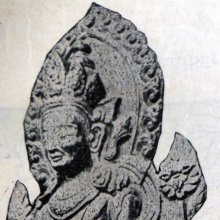Vishvapani, Viśvapāṇi: 4 definitions
Introduction:
Vishvapani means something in Buddhism, Pali, Hinduism, Sanskrit, the history of ancient India. If you want to know the exact meaning, history, etymology or English translation of this term then check out the descriptions on this page. Add your comment or reference to a book if you want to contribute to this summary article.
The Sanskrit term Viśvapāṇi can be transliterated into English as Visvapani or Vishvapani, using the IAST transliteration scheme (?).
Images (photo gallery)
In Buddhism
Tibetan Buddhism (Vajrayana or tantric Buddhism)
Source: archive.org: The Indian Buddhist IconographyViśvapāṇi (विश्वपाणि) is the name of the Bodhisattva offspring associated with Amoghasiddhi: one of the Dhyāni-Buddhas, according to Vajrayāna or Tantric Buddhism.—His colour is green; and his symbol is the viśvavajra .—Viśvapāṇi, as the name indicates, is the holder of the Viśvavajra or the double thunderbolt which is the symbol of the Dhyāni Buddha Amoghasiddhi, whose spiritual consort is Tārā or Tāriṇī. They all belong to what is called the Karmakula to which the green colour is assigned. Viśvapāṇi thus is green in colour and shows the Viśvavajra on a lotus. When represented, he may stand erect or sit in different sitting postures.

Tibetan Buddhism includes schools such as Nyingma, Kadampa, Kagyu and Gelug. Their primary canon of literature is divided in two broad categories: The Kangyur, which consists of Buddha’s words, and the Tengyur, which includes commentaries from various sources. Esotericism and tantra techniques (vajrayāna) are collected indepently.
India history and geography
Source: What is India: Epigraphia Indica volume XXXI (1955-56)Viśvapāṇi is one of the Brāhmaṇa donees mentioned in the “Asankhali plates of Narasiṃha II” (1302 A.D.). When a grant was made to a large number of Brāhmaṇas, the chief amongst the donees seems to have been called Pānīyagrāhin especially. In the present record, though all the donees (e.g., Viśvapāṇi) are referred to as Pāṇigrāhi-mahājana, their list is headed by a Brāhmaṇa with Pāṇigrahī as his surname.
These copper plates (mentioning Viśvapāṇi) were discovered from the house of a Santal inhabitant of Pargana Asankhali in the Mayurbhanj State (Orissa). It was made when king Vīra-Narasiṃhadeva was staying at the Bhairavapura-kaṭaka (city, camp or residence).

The history of India traces the identification of countries, villages, towns and other regions of India, as well as mythology, zoology, royal dynasties, rulers, tribes, local festivities and traditions and regional languages. Ancient India enjoyed religious freedom and encourages the path of Dharma, a concept common to Buddhism, Hinduism, and Jainism.
Languages of India and abroad
Sanskrit dictionary
Source: Cologne Digital Sanskrit Dictionaries: Monier-Williams Sanskrit-English DictionaryViśvapāṇi (विश्वपाणि):—[=viśva-pāṇi] [from viśva] m. Name of a Dhyāni-bodhi-sattva, [Monier-Williams’ Buddhism 203.]
[Sanskrit to German]
Sanskrit, also spelled संस्कृतम् (saṃskṛtam), is an ancient language of India commonly seen as the grandmother of the Indo-European language family (even English!). Closely allied with Prakrit and Pali, Sanskrit is more exhaustive in both grammar and terms and has the most extensive collection of literature in the world, greatly surpassing its sister-languages Greek and Latin.
See also (Relevant definitions)
Partial matches: Vishva, Pani.
Full-text: Amoghasiddhi, Dhyanin.
Relevant text
Search found 2 books and stories containing Vishvapani, Vishva-pani, Viśva-pāṇi, Visva-pani, Viśvapāṇi, Visvapani; (plurals include: Vishvapanis, panis, pāṇis, Viśvapāṇis, Visvapanis). You can also click to the full overview containing English textual excerpts. Below are direct links for the most relevant articles:
